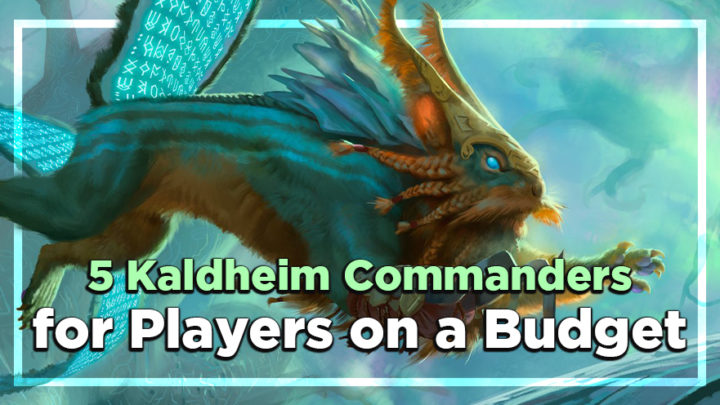With each new set come new commanders, and Kaldheim is no different. There are a whopping 33 new legendary creatures in the set, each with their own unique design and style. Some of them will be more suited to casual playgroups than others, but a few of them could end up among the most powerful commanders to be printed so far.
But if you’re like me, you don’t want to commit fully to a new commander without trying it out first. There are so many options, how do you know which one is right for you? That’s what I’m hoping to help you with here: I’ll be looking at five impressive new commanders from Kaldheim, and I’ll take you through some of the different builds you can achieve with them. I’ll be viewing this from a budget standpoint, too, so you can rest easy knowing that you don’t have to break the bank to commit!
Magda, Brazen Outlaw
It’s not every day that we get a tutor effect in the command zone, so when a new one arrives, it’s worth examining closely. Upon first glance, Magda, Brazen Outlaw reads like a dwarf tribal commander, and while you can absolutely build her as such, I believe she’s best utilized as a toolbox commander.
While it’s pretty obvious to add the usual treasure generators like Pirate’s Pillage, the base of most Magda builds will likely be a team of small dwarves and ways to tap them. Cards like Survivors’ Encampment and Springleaf Drum are excellent ways to make your mana base support this goal, and Kyren Negotiations is a great way to apply some pressure at the same time. And of course, you can always attack with your dwarves to tap them, too!
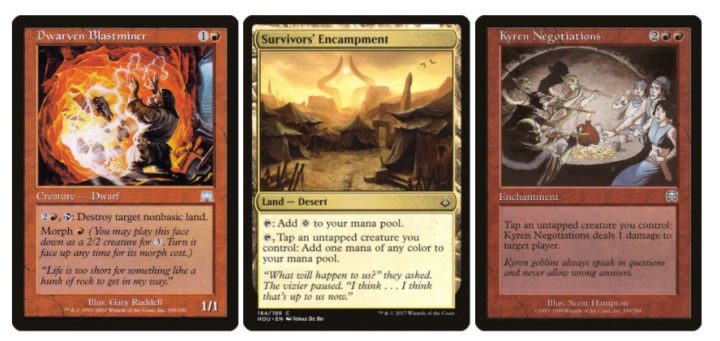
There are plenty of other ways you can benefit from tapping creatures: Throne of the God-Pharaoh gives you some extra reach, and Cryptic Gateway lets you cheat out even more creatures.
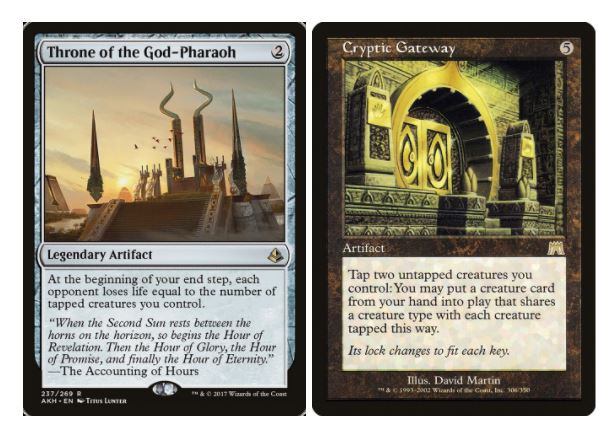
With all this tapping, you’ll be generating an awful lot of treasure. That’s excellent for ramping into bigger payoffs, but what if you don’t have the payoff you need in hand? This is where Magda comes to your aid. For the low cost of five treasures, she’ll grab you any dragon or artifact! It’s an exceptionally potent ability, even on a budget. There are a number of dragons that can be situationally powerful: Scourge of Valkas for repeatable removal, Hellkite Charger for extra combats, or even Dragon Mage to wheel into more gas.
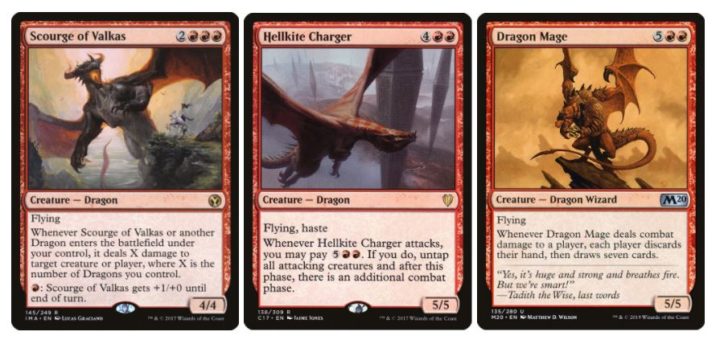
Your options really start to open up once you include some artifact tutor targets. You can grab hate pieces like Damping Sphere, a board wipe with Nevinyrral’s Disk, or card draw with Skullclamp. You can even tutor for combo pieces: Basalt Monolith, Rings of Brighthearth, and Codex Shredder generate infinite mana and mill your opponents out.
If you’re looking to upgrade the deck in the future, more pricey cards like Dockside Extortionist and Blightsteel Colossus would dramatically increase its competitive viability. Whether you decide to build Magda, Brazen Outlaw as dwarf tribal, toolbox, or a mix of everything, you’ll be sure to surprise opponents with her unusual power!
Vega, the Watcher
There’s nothing I love more than being rewarded for simply casting spells. Vega, the Watcher is a fantastic commander for anyone looking for a different way to gain value for casting spells in unusual ways. I’ve decided to dive into Vega for a unique take on spellslinger strategies.
Typically, these sorts of decks are all about gaining incremental advantages while casting efficient instants and sorceries, and are most commonly in the Izzet color pairing. Vega is unusual in that you’re aiming to cast spells outside of your hand for value, and you have access to white mana.
First up, let’s take a look at some of the spells that can be cast from other zones. The new foretell mechanic from Kaldheim is naturally great for this, but there are a myriad of other mechanics that fit beautifully in this deck. To help you with brewing, here’s a list of some spell mechanics that work with Vega’s ability:
- Foretell
- Flashback
- Jump-start
- Suspend
- Cascade
With Vega on board, Ravenform will draw a card while exiling, flashing back Deep Analysis now draws three cards, and Sakashima’s Protege somehow generates even more value!
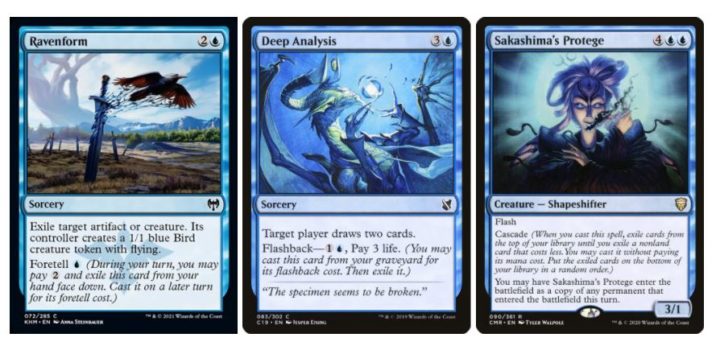
Future Sight is another excellent addition to any Vega deck, and Magus of the Future and Precognition Field are brilliant additional copies of the enchantment. Taigam, Ojutai Master is a real powerhouse here; making instant and sorcery spells uncounterable guarantees that your critical board wipe will resolve, and giving spells rebound really makes the value snowball out of control.
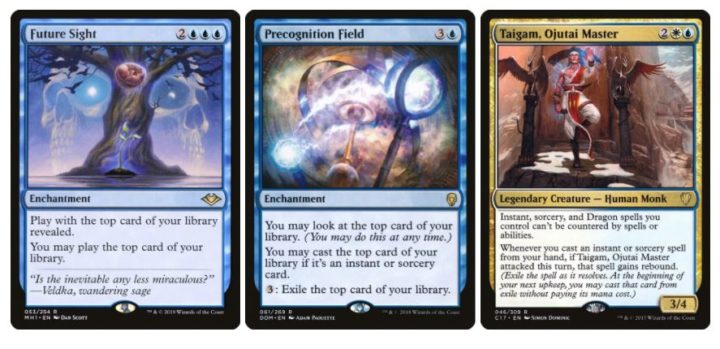
I mentioned Vega, the Watcher can be used as a spellslinger commander, and no spellslinger worth their salt leaves home without token generators. Murmuring Mystic, Talrand, Sky Summoner, and Metallurgic Summonings are the three best “board-in-a-box” cards available to you in Azorius, and they can really hold their own against many creature strategies.
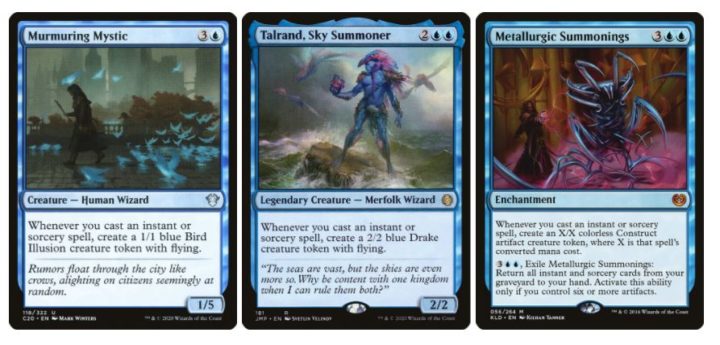
While you can just win with creature beatdowns while controlling the game, there is a real threat of drawing TOO many cards! I’d recommend adding a Thassa’s Oracle or Jace, Wielder of Mysteries to make sure you don’t draw yourself into a corner. If you wish to upgrade them over time, you can add a combo like Dramatic Reversal + Isochron Scepter. Since you’re casting a spell from outside of your hand, you will draw your entire deck with Vega on board to win with Thassa’s Oracle; if Vega isn’t on board, you can always just Brain Freeze your opponents for the storm kill.
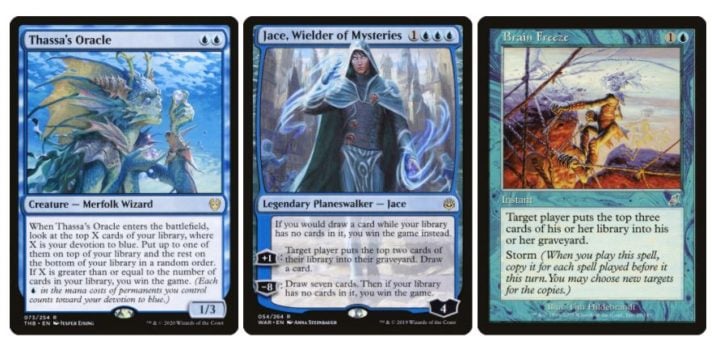
While Vega, the Watcher feels more reserved as a spellslinger than their Izzet counterparts, that’s not something that’s difficult to achieve. This would be a fantastic deck choice for you if you want something a little off the beaten path, or a deck with a more comfortable pace.
Toski, Bearer of Secrets
Many Magic players love squirrels (it’s practically a requirement at this point), so it’s no surprise that when Toski, Bearer of Secrets was revealed, the community was elated. When I first saw Toski, I immediately decided to try and make a squirrel tribal deck with our new legend at the helm. However, the love-to-support ratio for squirrels in Magic is possibly the widest of all creature types in (except for maybe dogs), so even the best builds would be lackluster. That’s why I’ve decided to explore Toski’s potential as a powerful aggro commander instead.
Toski’s ability to draw a card whenever a creature you control deals combat damage to a player is an incredibly powerful one. Aggressive strategies often fail when they’re hit by a sweeper and can’t recover in time, and this is usually due to a lack of card draw. While Toski is on board, your creatures effectively replace themselves when they deal damage just once!
Building a Toski deck with an aggro game plan will require a critical mass of small creatures to maximize their card draw capability. The easier they can connect with your opponents, the more effective they’ll be. Creatures like Scryb Sprites, Treetop Scout, and Gingerbrute are perfect for the job, thanks to their natural evasiveness.
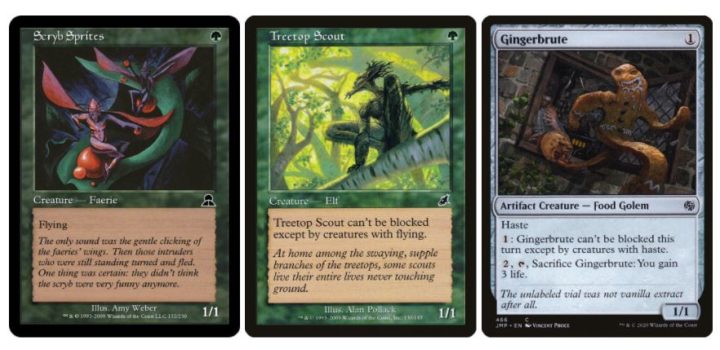
You can add cards like Ohran Frostfang or Beast Whisperer for additional card draw, should you need it. It’s also worth adding utility creatures like Manglehorn or Scavenging Ooze to be able to tackle any pressing issues you might be faced with.
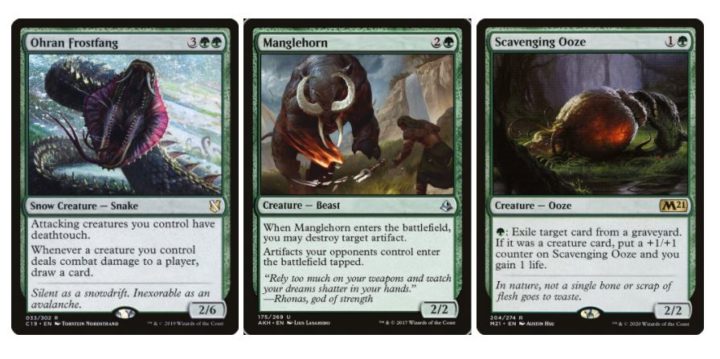
When it comes to mana ramp, it’s worth making use of some mana dorks like Llanowar Elves or Fyndhorn Elves; if they’re not needed for their mana abilities, you can always attack with them and draw more cards. Be careful with your dorks, though! The more you rely on mana dorks for ramp, the more susceptible you are to board wipes; I wouldn’t use them as more than 50% of the ramp in your deck.
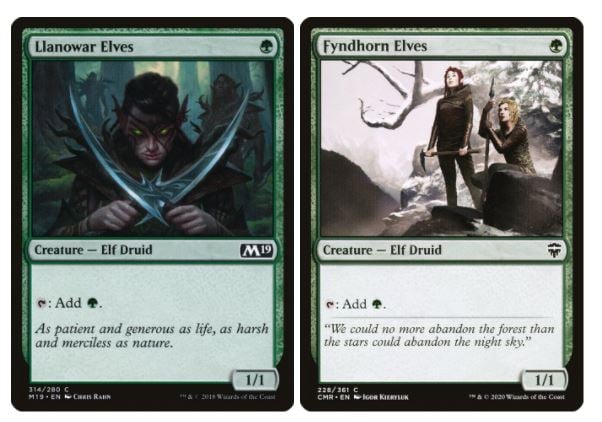
If you really fear sweepers, you can add a number of vehicles with low crew costs to mitigate the impact they can have on your board. Aethersphere Harvester, Untethered Express, and Fleetwheel Cruiser fit this description perfectly; if you lose your creatures to a sweeper, you can just play some more, crew your vehicles, and get right back to attacking!
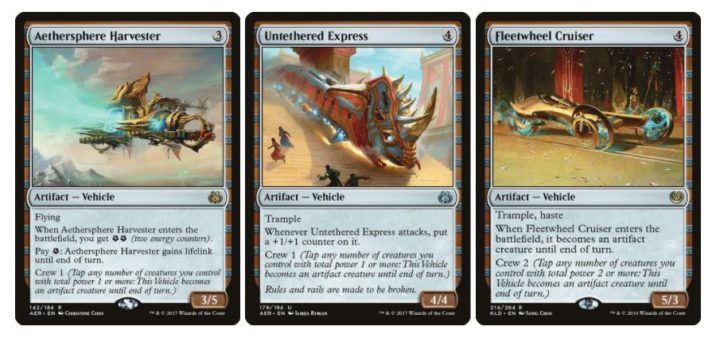
This is lining up to be a powerful deck with a number of ways to minimize board wipes, but you also need to maximize pressure. There are a number of ways you could address this: static effects like Signal Pest or Gaea’s Anthem can grow your team to shorten your clock, or one-shot effects like Overrun still get the job done in record time.

Toski, Bearer of Secrets is one of the most powerful budget aggro commanders we’ve seen in a very long time, and can stand up to decks ten times the price. If you’re looking to boost the power of your legendary squirrel even further, there are a number of more expensive pump spells that are worth consideration. Pathbreaker Ibex, Craterhoof Behemoth, and Triumph of the Hordes are all fantastic upgrades to your end game.

Firja, Judge of Valor
Firja, Judge of Valor is an interesting new addition to the Commander roster. They sport an uncharacteristic ability that seems almost more Izzet than Orzhov. Casting two spells to get a free Strategic Planning is not a typical black/white design, though it’s nice to see different colors getting access to new abilities. It’s not hard to cast two spells in a turn, and with at least two cards incidentally hitting the graveyard almost every turn, you can use Firja for something a little more natural to Orzhov: Reanimation!
First of all, you have a number of ways to make casting two spells each turn a breeze. Yahenni’s Expertise and Sram’s Expertise each give you a great effect while allowing you to cast a cheaper spell from your hand for free. Flashback spells are another great way to take advantage of Firja’s ability. Cards like Lingering Souls and Sevinne’s Reclamation are two spells in one, plus they fit both the reanimation and value themes perfectly.
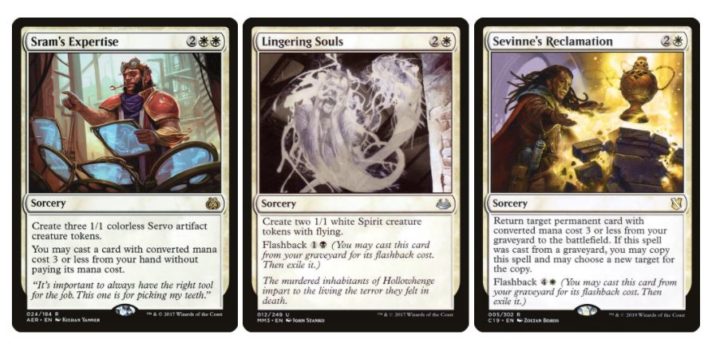
Once your graveyard is nice and stocked, it’s time to reanimate your most powerful creatures. Orzhov is overflowing with excellent reanimation spells: Unburial Rites, Dread Return, and Exhume are classics, and The Cauldron of Eternity and Debtors’ Knell will allow you to reanimate creatures repeatedly over multiple turns.

When it comes to reanimation targets, you’ll be spoiled for choice, even if you’re on a budget! Phyrexian Triniform and Akroma, Angel of Wrath are powerful threats; Blazing Archon and Ashen Rider make life difficult for your opponents; even Reya Dawnbringer and Sepulchral Primordial allow for more reanimation.

One additional way to gain value from these reanimation targets is to flicker them. Eerie Interlude, Flickerwisp, and Ephemerate are all excellent ways to eke out value in the early game (flickering smaller creatures like Wall of Omens), and then dash your opponents’ hopes later in the game by abusing more powerful effects.

If you’re looking to upgrade the build, there are a number of incredible reanimation targets you can add. Blightsteel Colossus, Sheoldred, Whispering One, and Avacyn, Angel of Hope are just some of the incredible options available at a higher budget.

Firja, Judge of Valor is a brilliant choice as a commander if you want to utilize a powerful graveyard strategy, but without being completely reliant on it. She’s more than capable of playing out a fair game with all the value she accrues, and you’ll be able to cast and flicker your huge payoffs eventually!
Orvar, the All-Form
At first glance, Orvar is just a better Mistform Ultimus. This really doesn’t do them any justice, though — their first ability is so unique and powerful that they have the potential to create an entirely new strategy, which I’m calling “Cloneslinger.”
The idea behind Cloneslinger is simple: cast instants and sorceries, and be rewarded with copies of permanents! This deck runs a lot of bizarre cards, and they can all target your own permanents so Orvar can copy them. Twiddle, Dream’s Grip, and Gigadrowse can tap any permanent, meaning you can use this to copy creatures, artifacts, even lands! You’ll need very few actual ramp spells, thanks to Orvar’s ability.

Some other spells can also draw extra cards while Orvar copies things: Cerulean Wisps, Shadow Rift, and Leap all draw a card on resolution, so you can keep your hand nicely stocked at the same time.

One of the best ways to maintain control of the board is to take advantage of Gadwick, the Wizened. Not only are they great for refueling in the late game, but you can turn your Twiddle effects and unusual cards into additional tap effects. You can use this to stop creatures from entering the red zone, or just to tap down an opponent’s Sol Ring in their upkeep.
Protection spells are important to keeping Orvar around, and there are plenty of excellent choices. Cards like Dive Down, Mizzium Skin, and Shell Shield not only stop targeted removal, but they can be used to copy other creatures in a pinch.

In order for these spells to reach their full potential, we need good targets for them. There are plenty of options available to even the most budget-conscious player. Cloudkin Seer, Archaeomancer, and Diluvian Primordial can generate value in a number of different ways, and Man-O’-War can bounce troublesome creatures. You even copy Voidmage Husher and Draining Whelk to counter spells and abilities at will!

The most effective way to close out the game in this deck is to repeatedly target scary creatures like Agent of Treachery or Tidespout Tyrant, both of which will cause most players to scoop after you make a couple copies. You can also go infinite with Peregrine Drake and Whim of Volrath; as Archaeomancer untaps five lands and Whim costs only three with buyback, you can make an arbitrarily large number of Drakes in addition to infinite mana!

Orvar, the All-Form is exactly the kind of deck I personally love to play. You’re playing with strange cards and unpredictability to keep your opponents off-kilter until you find a way to squeeze out an utterly nonsensical win… or go out with a bang.
I hope these ideas have helped inspire your next Commander build. Kaldheim has once again shown that no matter what level of Commander you want to play, or what your budget may be, you’re truly spoiled for choice!
How would you build these commanders? What’s your favorite commander from the set? Let me know on Twitter!

Scott is an Irish content creator and the Head of Budget Magic for the Izzet League. He focuses on affordable decks in Pioneer, Modern, and Pauper, particularly ones that stray from the mainstream. When he’s not writing about his favorite decks, he can be found talking incessantly about them on Twitter and on The Budget Magic Cast.

